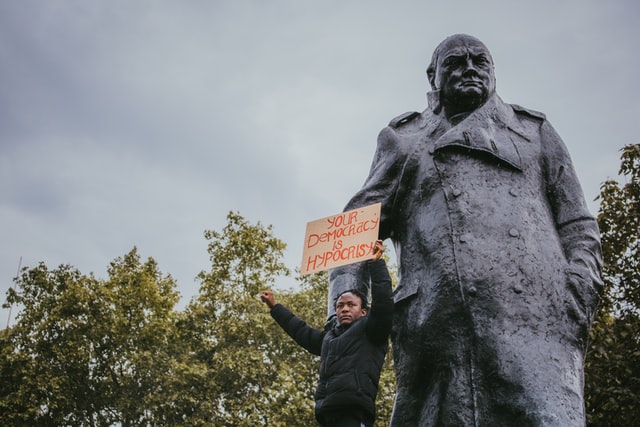Justification of democracy has become an essential theme in the current literature on political philosophy. Different factors have created the conditions for this to happen, but mainly they can be resumed in two characteristics. On one side, democracy is in crisis due to the rise of extremist politicians from every side of the political spectrum. On the other hand, in some contexts, polarization has escalated due to the increased economic discontent.
It seems this is a moment of transition in which the interrogation of our fundamental values is at stake.
The most recent collaboration of Steven Levitsky and Daniel Ziblatt, both Harvard professors, with the title How democracies die is, in the first place, a testimony of the hidden subtleties of that concept. In the second place, it also constitutes an essential questioning of democracy and its scope in the contemporary world. Finally, it is a theoretical attempt to tackle this situation, particularly in the United States of Donald Trump.
Both authors are outstanding references in the academy regarding political sciences and democracy studies. Steven Levitsky is a Harvard professor of government. He has been interested in political parties, authoritarianism, and democratization, focusing primarily on Latin America. Among his works, we can find Informal Institutions and Democracy: Lessons from Latin America (2006) and The Resurgence of the Left in Latin America (2011).
His partner, Daniel Ziblatt, studies Europe and the history of democracy. He is the author of Conservative Parties and the Birth of Democracy (2017) and Structuring the State: The Formation of Italy and Germany and the Puzzle of Federalism (2006). Currently, he is working on the research project Legacies of Destruction: Violence, Social Disruption, and Democracy, asking if violence can be a precondition for democracy.
Given the above, the book is an outstanding result of the activity of two reliable researchers. At the core of this collaboration lies the idea that democracy should not be given for granted. Not only because it can be discussed or even violated by authoritarian leaders but also because it has faced the criticism of several thinkers throughout the history of Western Civilization.
What both authors want to introduce is a simple idea, democratic values, like freedom and tolerance, can deny themselves passively. Well seen, it is not entirely disparate to think that implicitly, in democratic societies, there is a potential for the emergence of authoritarian politicians.
The beginning of the analysis leads us to reconsider the misconception that acts of violence like dictatorships, wars, and coups d’ état cause democratic breakdowns. Nonetheless, the truth is that in the last decades, the situation has been different; democracy has died “slowly, in barely visible steps” (p. 4).
The fact that violent breakdowns are not anymore undermining the democratic process constitutes a real problem for honest politicians, scholars, and, ultimately, citizens. There is no way to know when democracies are dying or not if we do not have clear evidence of it. “Since the end of the Cold War, most democratic breakdowns have been caused not by generals and soldiers but by elected governments themselves” (p. 6). The book comes accompanied by a historical description of well-known cases of democratic breakdowns, from Venezuela to Turkey, from Hungary to Peru and Ecuador, and last but not least, the United States of America.
Since the introduction, the authors define what democracy is. For them, it is “a system of government with regular, free, and fair elections, in which all adult citizens have the right to vote and possess basic civil liberties such as freedom of speech and association” (p. 8). However, it seems that America is in danger due to the increasing deterioration of democracy in the last few years. With the election of Donald Trump, it has been demonstrated that no matter how stable the institutions are, would-be authoritarians can win the presidential chair. Therefore, a question is on the table: Can democratic institutions combat the emergence of such figures? Is there any formal device that can help us to detect the real authoritarian leader?
In the first chapter, Fateful Alliances, the authors examine precisely the sort of coalitions that political parties have to make to avoid the emergence of authoritarian leaders. This is the core of the book not only because it clarifies how these pacts and approaches have to be made to face authoritarian leaders but also because it defines that: “what matters more is whether political elites and especially parties, serve as filters. Put simply, political parties are democracy’s gatekeepers” (p. 24). Along with the vital role of these gatekeepers, we find a set of Four Key Indicators of Authoritarian Behavior to detect authoritarian politicians from before. These are the rejection, in words or actions, of the democratic rules of the political game, the refusal of any legitimacy on the opponent’s side, the tolerance or encouragement of violence, and the evident willingness to curtail the civil liberties of opponents, including the Media.
It is under this set of rules that one can assess, define, and identify a would-be authoritarian. However, this is not the end because, after the identification, political parties must apply a strategy to oppose the would-be authoritarian. Pro-democratic organizations can root out the extremists at the necessary level of their parties, systematically isolate the anti-democratic politicians, and establish partnerships against the common enemy, even if that means crossing the lines of the party.
In Gatekeeping in America, they show how no demagogues have won the presidential chair in America. The latter is basically due to the creation of alliances and the job done by the gatekeepers. To support that idea, some historical examples are shown. Among other characteristics, the election of Donald Trump as president of the United States is the story of “ineffective gatekeeping.” This story is told in the chapter The Great Republican Abdication, where the reader can also find a clear definition of why and how Donald Trump fulfills the profile of the authoritarian leader. Then, in Subverting Democracy, they attempt to show how “elected authoritarians shatter the democratic institutions that are supposed to constrain them” (p. 93). This moment can also be seen as a practical implementation of the framework that they defined before. Here, the reader may again find one of the most important takeaways of the book: “The very defense of democracy is often used as a pretext for its subversion. Would-be authoritarians often use economic crisis, natural disasters, and especially security threats – wars, armed insurgencies, or terrorist attacks- to justify anti-democratic measures” (p. 113).
Sometimes well-designed democratic institutions cannot save citizenship; something else is necessary. In The Guardrails of Democracy, they define which are these guardrails: “Unwritten rules are everywhere in American politics, ranging from the operations of the Senate and the Electoral College to the format of presidential press conferences. However, two norms stand out as fundamental to functioning democracy: mutual toleration and institutional forbearance” (p. 125). As the reader can see, in addition to laws and institutions, the authors think that they need norms and unwritten rules to sustain the political practice. In The Unwritten Rules of American Politics, they describe the origin, function, and importance of many of these rules.
The Unraveling and Trump against the Guardrails describe the United States of America in the present day and how Trump has tried to impose his political style. Finally, the book tries to close with an optimistic note in Saving Democracy. The ultimate inquiries here are: what is democracy? Furthermore, how major political parties can overcome the situation and meet in the middle to find a solution? In this regard, they will give three possible scenarios: one pessimistic, one optimistic, and one with continued polarization.
The answer depends on the ability of active citizenship and political parties to awaken the hidden norms of the democratic game. Here, we will face a new situation that is already shaping America and part of Western societies. That is, to build a democracy without racial exclusion: “Few societies in history have managed to be both multiracial and genuinely democratic. That is our challenge. It is also our opportunity” (p. 285).
Despite the positive values of the text already pointed out throughout this review, some elements lead us to some criticism. The first obvious one is regarding the role of political parties as gatekeepers of democratic institutions; we think the fruitful continuation of this research it may be in the direction of making their model more concrete at the basic levels, in the roots of the political organizations. In the second place, the text barely mentions the role of traditional media, social media, and the different ways information is shaping our lives. Not only because of the well-known role of Cambridge Analytica during the Brexit and the election of Donald Trump but also because of how citizenship approaches politics today. Big Data and new technologies are changing the way we see the world. One has the impression and the perception that there is too much noise to understand each other properly in this political game.
Despite these challenges, we, along with the authors, believe that democracy transcends a mere collection of rules or hollow rhetoric. It serves as the foundational condition enabling us to lead meaningful lives, embracing freedom and fraternity with those around us. In times when democratic institutions face crises, Ziblatt and Levitsky’s work offers us a roadmap to rediscover and reaffirm our democratic values.
References
Steven Levitsky & Daniel Ziblatt. 2018. New York: Broadway Books. 320 pp. ISBN 9781524762940.




